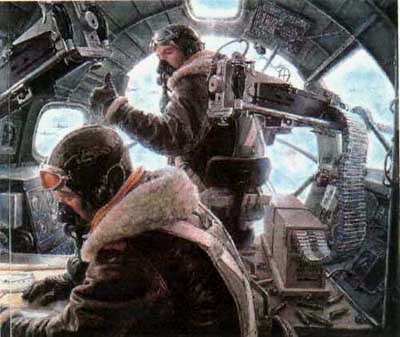5/29 - Chicago
At 4:15 p.m. on May 29, 2002, our family began a trip back in time to retrace our dad's steps from his crash landing in northwestern Holland on February 24, 1944, to his arrival at Stalag Luft I in northern Germany where he was held as a prisoner-of-war for 15 months until the War ended. It's impossible for us to put into words how Dad must have felt as he revisited the crash site near the town of Vijfhuizen, the Gestapo jail in Amsterdam, the railroad station in Frankfurt, the main interrogation camp at Auswertstelle West (Dulag Luft) in Oberursel, and the site of Stalag Luft 1 in Barth; but for us, the trip brought to reality this chapter of Dad's life that we kids knew only as stories that we shared as a family for many, many years.
5/31 - Amsterdam
We started our trip with a visit to the War Archives where we had an appointment with Joseph Dane, who provided us with maps and pictures of the jail (interior and exterior) that Dad had been taken to initially after his B-17 crash landed. From there we visited the site of the jail, itself, most of which had been demolished years ago. Although the exterior structure of the jail remains, the interior is now just a passageway from the street to the surrounding buildings beyond. We walked around back and found the canal that Dad remembered seeing on his way into the building in 1944. Mounted on one of the still remaining interior walls was a plaque commemorating those prisoners - Dutch resistance fighters, Jews and POWs - who went through this transit point on their way to concentration camps and prisoner-of-war camps within Germany. A translation of the plaque follows:

AMSTERDAM WAR ARCHIVES

THE JAIL IN AMSTERDAM

INSIDE THE JAIL DURING THE OCCUPATION

6/2 - Frankfurt
Today we took the train from Amsterdam to Frankfurt as Dad had done in 1944 . . . only this time, instead of a boxcar, Dad rode First Class on the high-speed ICE train. In Frankfurt we joined our tour group of eleven, which included four other former POWs from Stalag Luft 1 and their family members who were able to join them for our two-week tour of WWII Germany.

6/4 - Oberursel
Our next stop was Auswertstelle West (Dulag Luft) in Oberursel which had been the main transit and interrogation camp for captured Allied airmen during the War. By early 1945, it is estimated that over 40,000 POWs had passed through this camp. When we arrived, we were met by Mr. Gerhart Reiss, the town historian, who showed us the SS Officer's Club, the only building still standing of the original camp. The building, which had recently been put under State protection as a historical site, was boarded up for future restoration. For this reason, we were not able to access the front of the building, where a swastika (a variation of the Greek cross, which is supposed to be a sign of good luck and success) is said to be still visible on the left-hand column in the foyer.
AUSWERTSTELLE WEST (DULAG LUFT) - OBERURSEL



In April 1945, the camp fell into the hands of the US Army, and was renamed Camp King after Charles B. King, an intelligence officer during the invasion of Normandy in 1944. At war's end, the camp was used as an interrogation center for German POWs and during the Cold War as an intelligence post. Today, the site has been rebuilt as a German housing area. The only indication that the camp ever existed was a small street sign with the words, "Camp King Allee."
POST WAR U.S. ARMY BASE - CAMP KING

Then we visited a nearby hospital which lay a mile west of the camp and was where the seriously injured POWs were treated. There Mr. Reiss gave us a slide show that included aerial photographs and documents of Auswertstelle West (Dulag Luft) and of the officers stationed there. We also met the administrator of the hospital and one of the Sisters of the Catholic Order who provided us with refreshments. The hospital is now a psychiatric institute (Klinik Hohe Mark).

Then we went to the railroad station in Oberursel where the original tracks and depot still exist today. POWs were transferred to and from Frankfurt at this station.
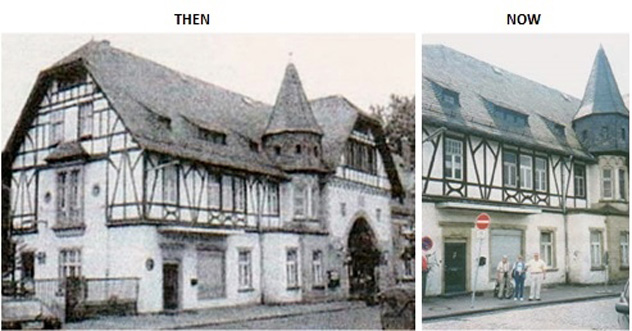
Oberursel railway station has changed little since the Second World War. From here, the POWs would be directed to cross the road (Hohemarkstrasse) and walk on to the Camp by foot.

6/8 - Barth
On this day, we left our hotel in Berlin for Barth in the rain. The sky cleared as we entered Rostock along Germany's northeastern shoreline, where Dad vividly remembered pumping his bicycle from Barth to Rostock and on to Wismar and the safety of the English lines at the end of the war. The bus left us in Rostock, where we picked up our rental car.
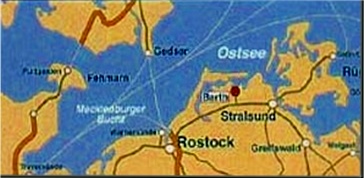
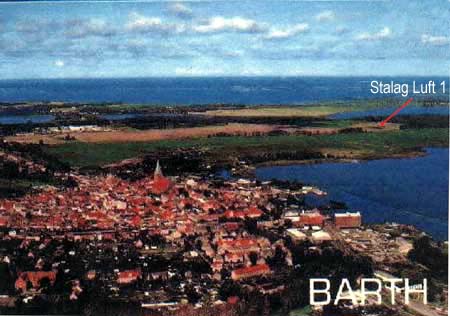
We took a nearby ferry over the Breitling Channel and followed the road along the coast into Barth. We ate our "homemade" sandwiches as we drove into the early afternoon.
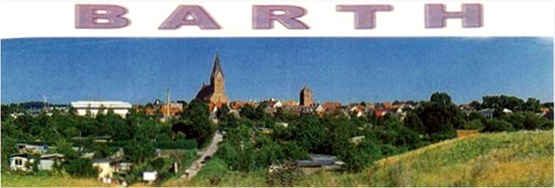
As we approached Barth, we saw a sign that read "STALAG LUFT 1" with an arrow pointing to the left. We stopped here and took several pictures.
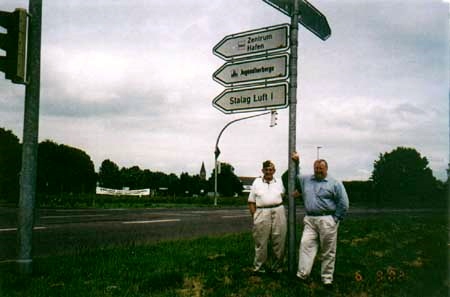
Following the main road into Barth, Dad saw for the first time since 1945 the arched West Gate that he and the other three officers from his crew had walked through on their way to the prison camp from the railroad station. Again, we stopped to take several pictures.
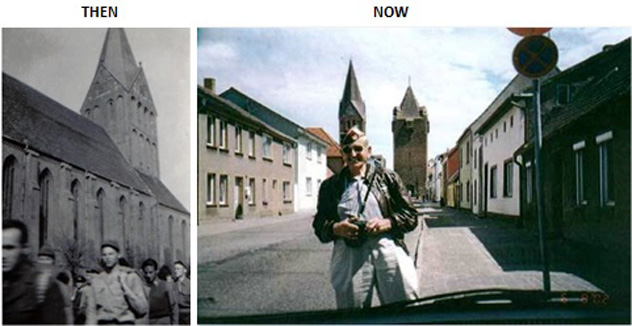
Then we drove into the heart of the town, itself, where we reunited with our tour group.
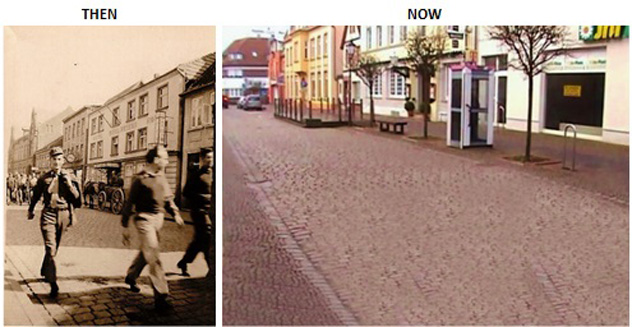
We were directed to a historical building in the town where we met Helga Radau, our German guide and local historian. Dad gave her a pin (German and American flags overlapping), and I gave her some flowers that I had bought for her along the way.
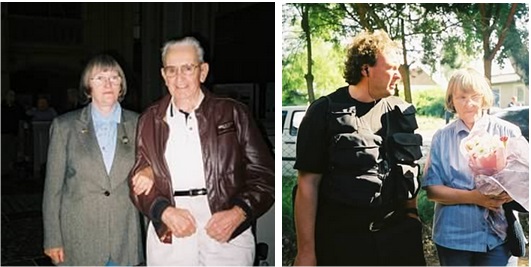
Barth is Helga's hometown. Born in 1941, she was a small child during the war but she well remembers the atrocities she witnessed at the hands of the Nazis and the Russians. She showed us a model of the town as it existed during the war and pointed out the house where she was born, the railroad station, the arched gate, and the POW and concentration camps northwest of the town. Originally, the town had four arched gates, but only the one remained at the time of the war. Helga spoke excellent English and was well informed about many details regarding the POW camp. You could say it had been her life's work. She was extremely friendly and had an admiration for the POWs that went back to the time as a child when the British had protected her and her mother from the Russians at the end of the war. Lots of pictures were taken and lots of years of questions were answered. There was nothing Helga didn't know. And for us, there was no measure of gratitude that could be expressed for the satisfaction we derived from listening to this remarkable lady.
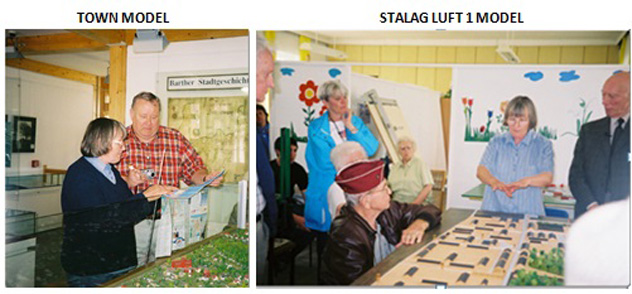
The POWs were marched north from the railroad station south of town through the center of the town to the arched West Gate (left of the church) where they headed west out of town on Barthestrabe (Barth Street) to Stalag Luft 1 on the outskirts of town.
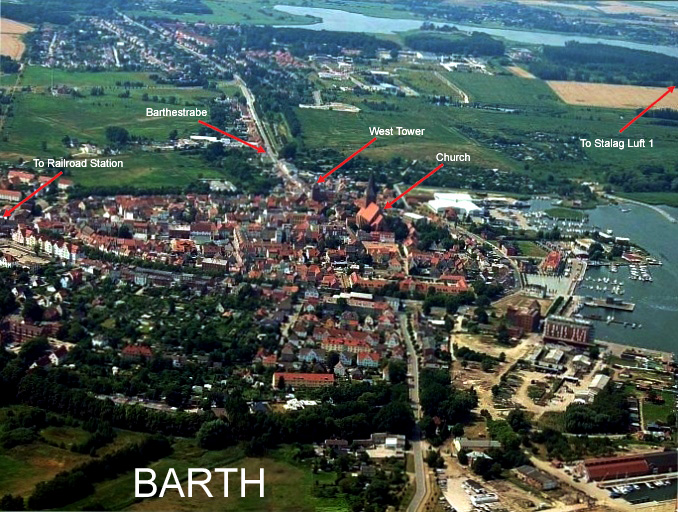
Helga introduced us to a British man, Roy Kilminster, a very proper gentleman, who had been a radio officer on a Halifax during the war and had spent three years in Stalag Luft 1, where he was the forger for the camp. Accompanying Mr. Kilminster was a BBC film crew that was filming a documentary on the war, lest we forget. They joined us on our trip out to the site where Stalag Luft 1 had been.
ARRIVAL OF NEW POWs AT STALAG LUFT 1
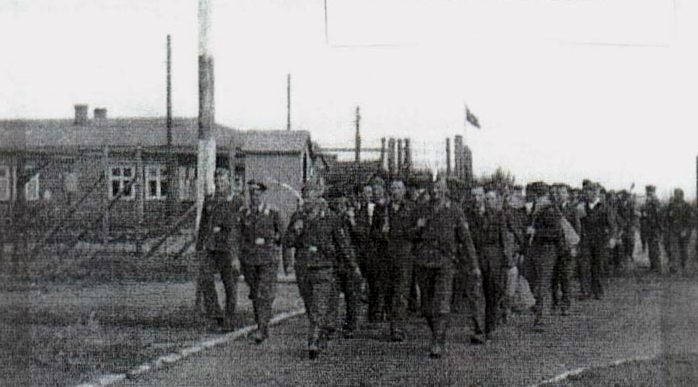
The film crew documented our visit to a monument across the road from the camp that had been erected by the people of Barth and dedicated to the POWs who had been held captive in the camp during the war.
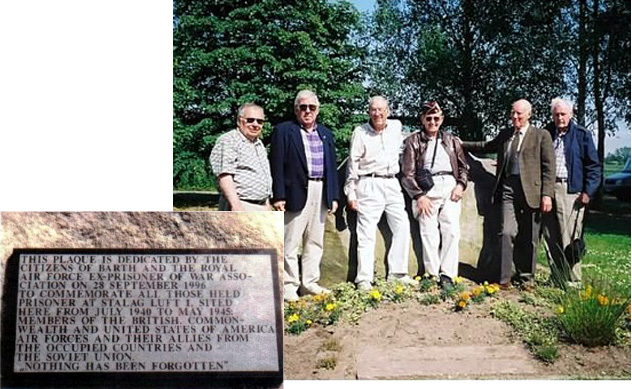
Then we visited the site of the Flak Training School south of the camp where the German soldiers had learned how to operate the 88mm guns used to bring down Allied planes.
FLAK TRAINING SCHOOL
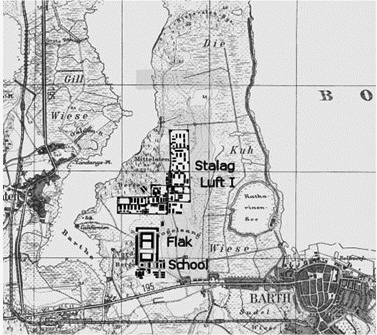
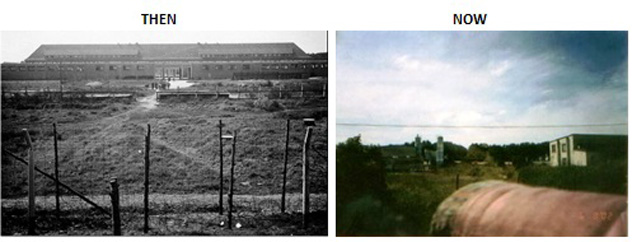
From there we took a path through the woods to the river where Dad had gone swimming a few times while at the camp. Helga also showed us an excavation site deep in the woods where the Germans had two barracks. We found pieces of two plates in the rubble (one with a Bavarian seal and the other with a Prussian seal).
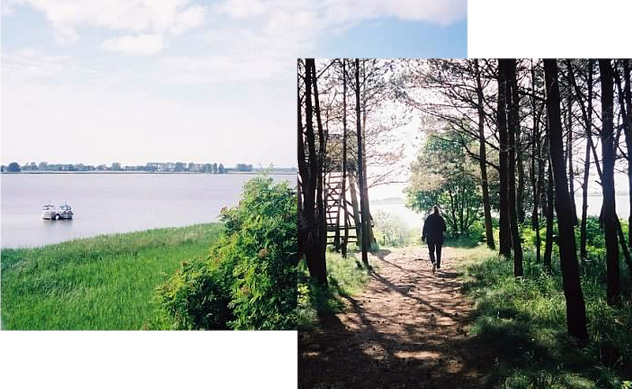
We followed the tour bus in our rent car to our hotel in Zingst. Our rooms, which overlooked the Baltic Sea, were like small houses with their kitchenettes. After dinner, we walked out to the pier and took a few pictures at sunset.
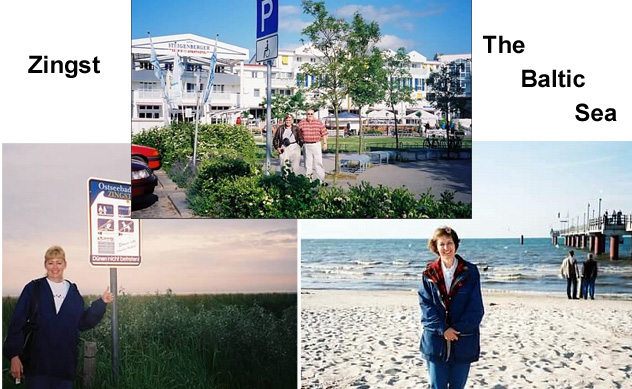
6/9 - Stalag Luft 1
On this, our last day in the area, we again followed the bus back to Barth where we met Helga at the town church, which was built in the early 17th century, originally as the Catholic church, but later it became the Protestant church of the town. There were grave markers on the floor of the church (that were impossible to avoid stepping on) dating as early as 1607. From there, we went to City Hall where we met the mayor of Barth, Bergermeister Mathias Lottge, who gave us a history of the town and answered our questions.
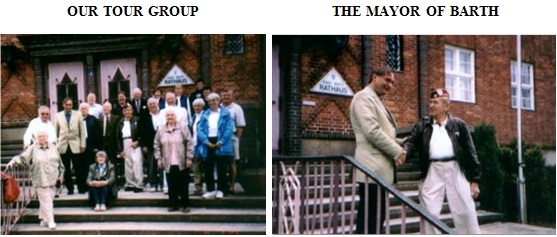
Mayor Lottge, Helga and the BBC film crew joined us for a wonderful lunch at the Hotel Stadt Barth in downtown Barth.
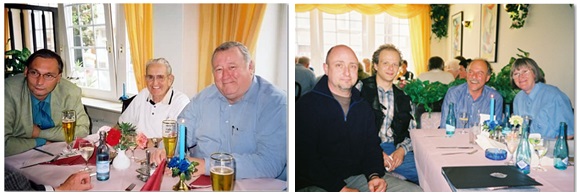
After lunch we visited the town memorial commemorating the victims of the concentration camp that was located just west of Stalag Luft 1 during the war. Dad stood at this wall while the BBC film crew interviewed him regarding his experiences as a POW. He did a good job, as always.
Interview With BBC Documentary Film Crew
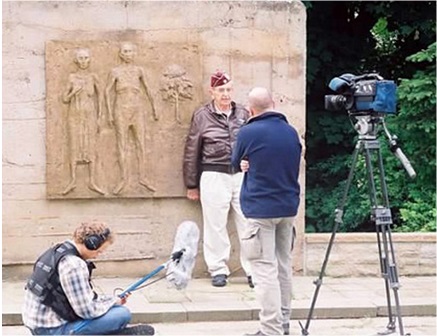
It was here that we said our last goodbyes to Helga with an exchange of hugs. Helga, you "will not be forgotten."
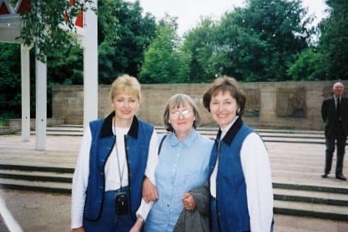
Since our lunch took so long, we decided to skip our original plan to drive through Rostock and on to Wismar in order to retrace Dad's bicycle route out of the camp on his way to the British lines. Instead, we drove back to Stalag Luft 1 and back in time to 1944.
German Guards Entering North Compound 1
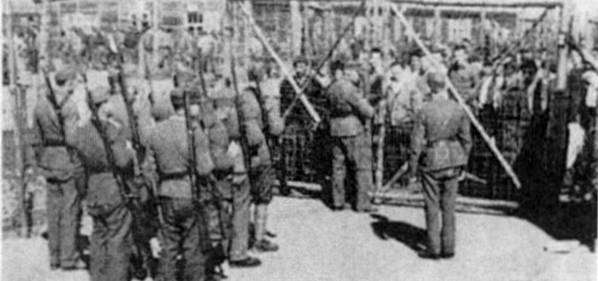
Warning Wires Between Compounds
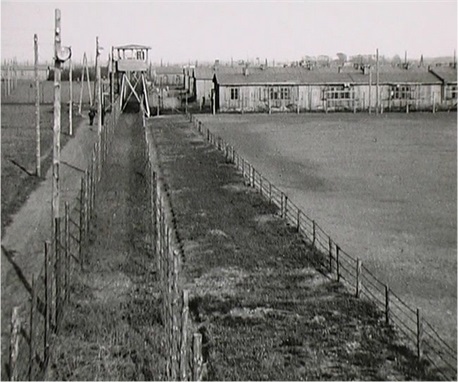
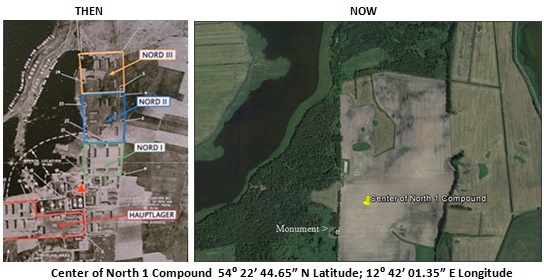
1944
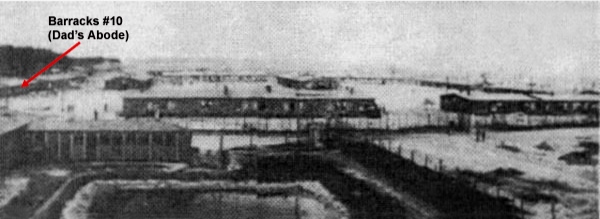
2002
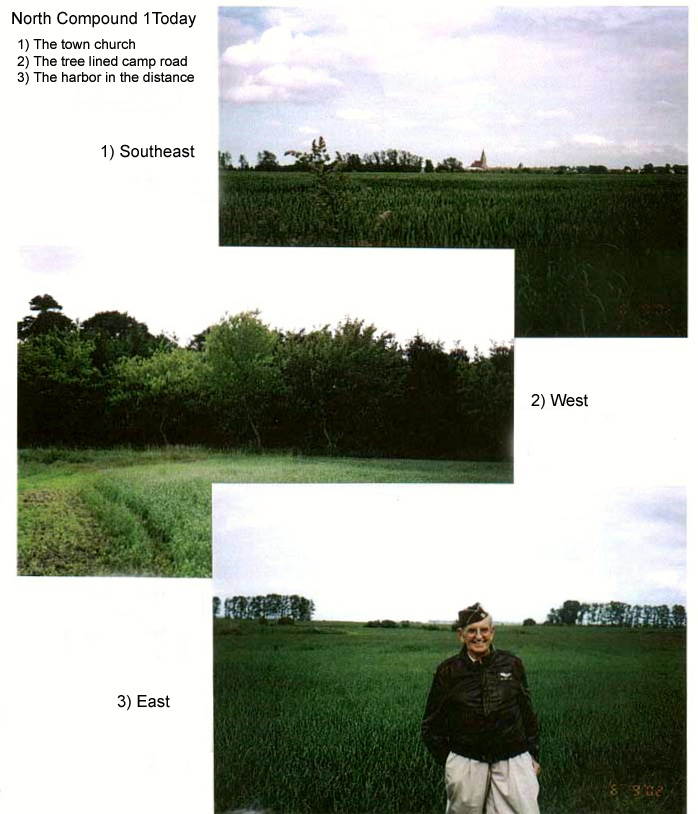
Our visit to the camp the previous day as a group had been impersonal and rushed. But our re-visit on this day was all that we had hoped it would be. On this visit, we (being alone) had an opportunity to take our time and to reflect, individually and collectively, what this spot had meant to Dad (and to the nine thousand like him) during and since the war. Although the camp was destroyed at the end of 1945 after being used for a short time as a "re-indoctrination camp" by the Russians, echoes of the former camp still remained. The sound of the wind in the trees, the nearby harbor with its passing sailboats, the single lane camp road that divided the compounds, and the steeple of the church in the town of Barth looming high against the flat horizon still exist as they did 58 years ago. As we stood as a family in this field of tall grass that had been North Compound 1, it was definitely a time for reflection. We couldn't help but wish that Mom could be here with us on this spot where Dad had spent much of his time writing her countless letters confirming the love they shared and the future they would have together (and perhaps she was). We each gave thanks to the Lord for bringing Dad back home safe and sound and for the many wonderful years we had had together as a family.
Father and Son - 1945 and 2002
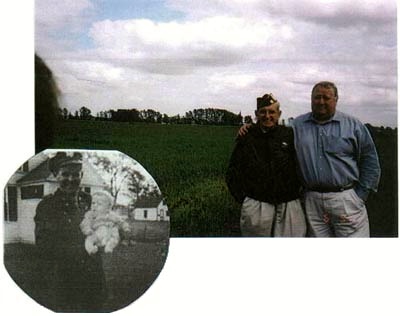
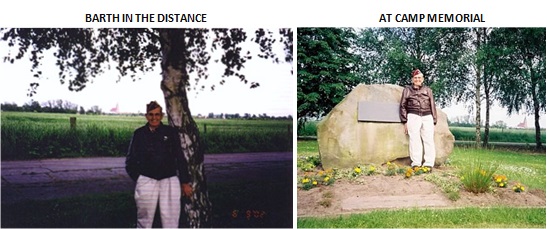
We drove north on the camp road to where the flak school used to be and where the concrete foundation for the 88mm guns is still visible, and then turned around to leave. As we slowly passed North Compound 1 again, we noticed what looked like a pillar in the tall grass about half way into the field. Upon closer inspection, we found, to our delight, that there were actually three pillars made of yellow brick, we think to be all that remains today of the North Compound 1 kitchen and mess hall that the Kriggies had burned down, an event that Dad witnessed but did not partake in. We drove the car into the field so Dad could have a closer look before we drove out of the camp for the last time.
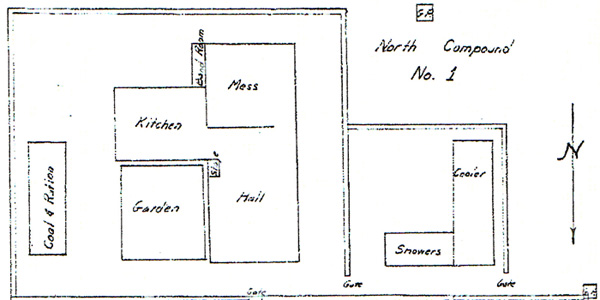
REMAINS OF THE NORTH COMPOUND I MESS HALL
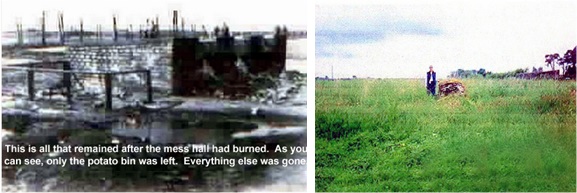
6/13 - Zurich
Having toured through much of historical Germany, we departed for the United States from Switzerland, which was home base for our tour bus. At the airport, most of our group scattered to the four winds as they went their separate ways to connect with their Swissair flights to their various destinations in the States. In a way, this was good because the goodbyes had to take a back seat to the pandemonium of the morning. Sitting together as a family for the last leg of our trip home, we spent much of our flight reminiscing events of the past two weeks that have been etched in our memories forever.
It was a good trip, our trip to Stalag Luft I and back.
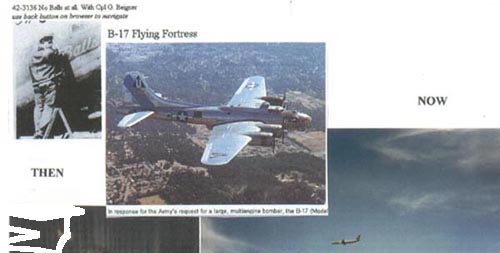
In loving memory of Dad's son and our brother, Arthur Peter "Pete" Starratt, author of the previous pages of this web site, who died unexpectedly on August 22, 2002, two months after our return from Germany.
